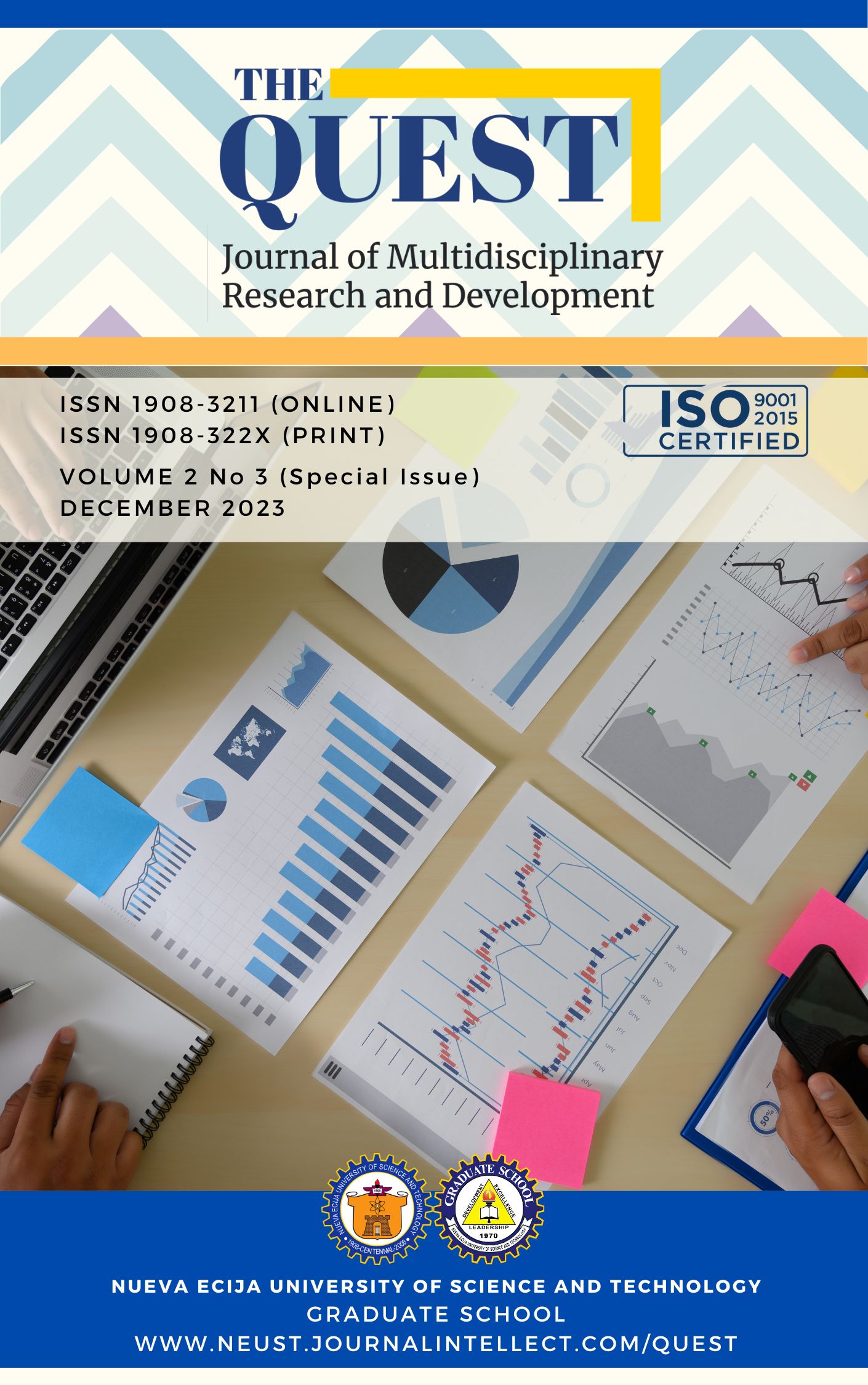Integration of Information Technology in Higher Vocational Economic and Trade Disciplines: Inputs for a Development Plan

Published 12/30/2023
Keywords
- information technology,
- integration
How to Cite
Copyright (c) 2023 The QUEST: Journal of Multidisciplinary Research and Development

This work is licensed under a Creative Commons Attribution-NonCommercial 4.0 International License.
Abstract
This study was carried out for the integration of information technology and economics and trade disciplines. It analysed the integration of information technology and vocational economics and trade disciplines, the effectiveness of information technology integration, administrative support for the integration of information technology and vocational economics and trade disciplines, the advantages and disadvantages of information technology and other aspects.It was found through the study that integration of information technology with vocational economics and trade subjects is conducive to innovative teaching methods, providing more opportunities for communication between students and teachers, and obtaining teaching evaluations. By providing administrative support for the integration of information technology and vocational economics and trade disciplines, building digital training rooms, and purchasing information technology systems, the integration of information technology and the curriculum will be more effective, and the information technology literacy of teachers and students will be significantly improved. Strengthening the integration of information technology and economic and trade disciplines, teaching content is livelier and more interesting, students are more active in learning, and teaching feedback is timelier. For this reason, this study gave a theoretical explanation from the process of integration of information technology and economics and trade subjects. It is made clear that carrying out the teaching of integrated marketing practice system can only form a new educational impact and play a new educational role if it is accepted by both teachers and students.
References
- Abeysekera, L., & Dawson, P. (2015). Motivation and cognitive load in the flipped classroom: definition, rationale, and a call for research. Higher Education Research & Development, 2015(1).
- Chen, K., Li, F., & Jiang, X. (2015). Influencing factors and countermeasure choices for the development of virtual research organization in the construction of informationization in higher education. Journal of Distance Education, 33(06), 70-77.
- Chen, Y., Wang, Y., Kinshuk, & Chen, N. (2014). Is FLIP enough? Or should we use the FLIPPED model instead? Computers & Education, 2014.
- Hassanzadeh, A., Kanaani, F., & Elahi, S. (2012). A model for measuring e-learning systems success in universities. Expert Systems With Applications, 2012(12).
- Hu, M. (2010). Research on the Application of Customer Relationship Management in Business Schools [D]. East China Normal University, 2010.
- Hu, Q. (2009). Framework and Trend Analysis of Higher Education Informatization Development. Education Research, 2009(10).
- Huang, R., Zhang, J., Hu, Y., et al. (2012). Smart campus: the inevitable trend of digital campus development. Open Education Research, 18(04), 12-17.
- Lage, M. J., Platt, G. J., & Treglia, M. (2000). Inverting the Classroom: A Gateway to Creating an Inclusive Learning Environment. The Journal of Economic Education, 2000(1).
- Legris, P., Ingham, J., & Collerette, P. (2002). Why do people use information technology? A critical review of the technology acceptance model. Information & Management, 2002(3).
- Li, B., Zhang, W., Zhang, S., et al. (2016). Modeling the influencing factors of learning satisfaction in blended learning. Journal of Distance Education, 34(01), 69-75.
- Li, T., Zhang, P., & Wang, Z. (2005). Analysis of key factors affecting users' acceptance of information technology. Forecasting, 2005(04).
- Liu, B. (2022). A Study on Strategies for Enhancing the Effectiveness of Online Learning for College Students Based on the Theory of Community of Inquiry. Shandong Normal University, 2022.
- O'Flaherty, J., & Phillips, C. (2015). The use of flipped classrooms in higher education: A scoping review. The Internet and Higher Education.
- Peng, S. (2012). A study on the key factors of users' adoption of microblogging based on UTAUT model [D]. Beijing University of Posts and Telecommunications, 2012.
- Peng, W. (2023). How the sense of presence affects the willingness to consume live fitness broadcasts - the mediating effects of content quality and exercise self-efficacy. Journal of Guangxi Vocational Normal College, 2023.
- Wang, H., & Yan, B. (2021). Reflections on the Flipped Classroom Teaching of College English through the Output Oriented Approach. Journal of Liaoning College of Education and Administration, 2021.
- Wu, M., Liu, H., & Ren, Y. (2015). "Internet+" campus: A new stage in the construction of university smart campus. Journal of Distance Education, 33(04), 8-13.
- Xu, H., Chen, H., & Yuan, K. (2022). A study on the effectiveness of flipped classroom in higher vocational colleges based on curriculum diagnosis and improvement. Knowledge Window (Teacher's Edition), 2022.
- Xu, S., Li, C., Fan, G., & Xiao, P. (2022). Research on the application of flipped classroom in teaching digital media majors in colleges and universities across the Taiwan Strait and in three regions. The 17th Cross-Strait (Guangdong-Taiwan) Higher Education Forum, 2022.
- Yang, Y., & Huang, Y. M. (2022). Exploring the teaching mode of teacher education theory courses in higher vocational colleges and universities--Taking mathematics curriculum standard and textbook analysis course as an example. University Education, 2022.
- Yao, L. (2004). Research on effective teaching [D]. East China Normal University, 2004.
- Zhang, J. (2021). A Study on Teaching Knowledge Enhancement Strategies for Teacher Trainees Integrating Technology. Kashi University, 2021.
- Zhang, X. (2010). Quality management based on information system. Information Systems Engineering, 2010(04).
- Zu, B., He, Y., Chen, F., & Li, T. (2022). A study on the design and application of flipped classroom based on ARCS motivation model: a perspective of deep learning. China Medical Education Technology, 2022.
- Tsai, P. L. . (2018). Progress and Future Direction of Research on Information Technology and Curriculum Integration. Curriculum . Teaching Materials. Teaching Methods (08), 133-143. doi:10.19877/j.cnki.kcjcjf.2018.08.020.
- He, K. S.. (2007). Education informatisation and the deepening reform of university teaching. China University Teaching (10), 64-71.

